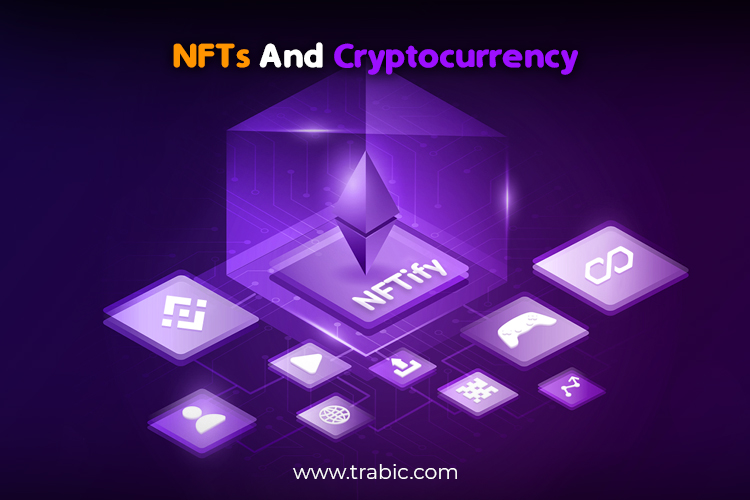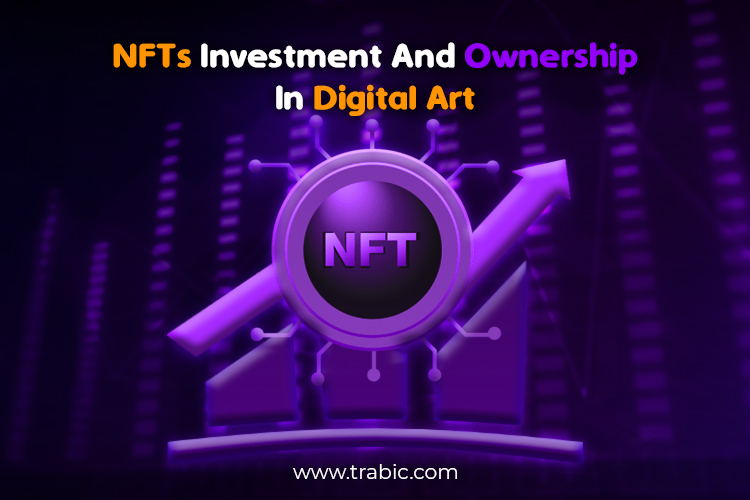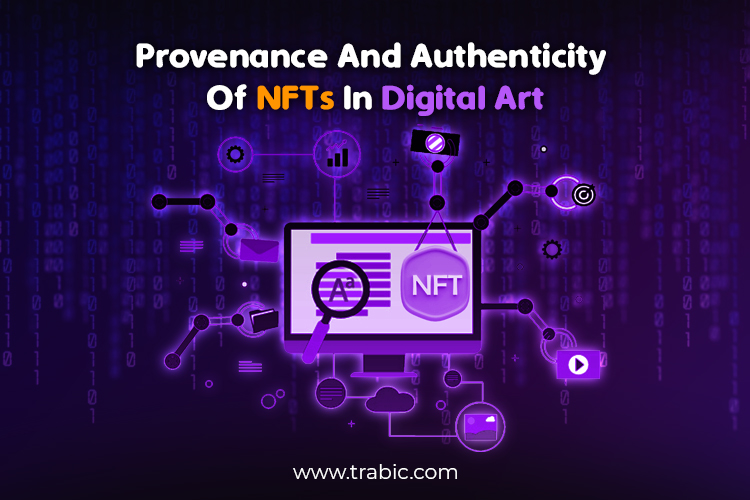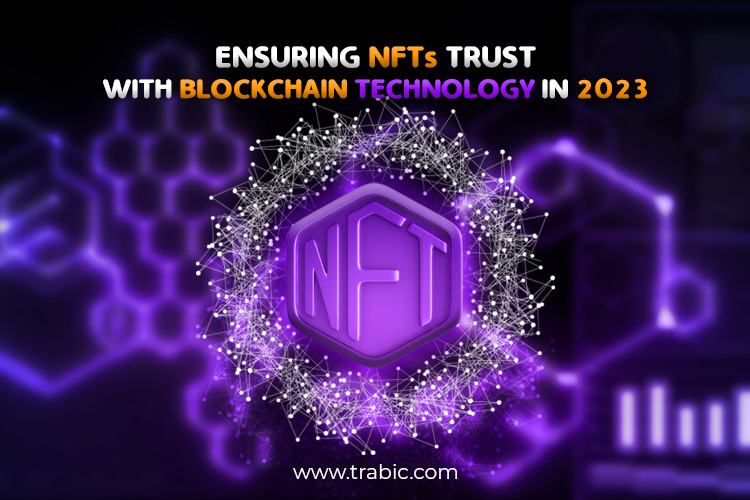Digital art and NFTs (non-fungible tokens) are closely linked, as they have emerged as a new way to trade digital art. NFTs are unique digital tokens kept on a blockchain, and they can be used to symbolize the ownership of digital assets, including digital art, music, videos, and other media-related creative content. They have become popular in art because they provide a way to verify ownership of digital art and establish its value.
One of the primary advantages of using them for digital art is that they allow artists to monetize their creations in an impossible form. By selling them representing ownership of digital art, artists can generate income from their work and establish a market for their creations. In addition, they can provide a way for collectors to buy and own digital art securely and verifiable.
Because NFTs are held on a blockchain, they provide a permanent record of ownership that cannot be easily disputed or forged. However, some challenges are associated with the help of them for digital art. One of the central difficulties is the environmental impact of blockchain technology, which requires a significant amount of energy to maintain. Additionally, the market for non-fungible tokens is still relatively new and evolving, and there is some uncertainty about how it will develop.
NFTs have appeared as a new way to buy, sell, and collect digital art, and they offer some unique benefits and challenges for artists, collectors, and the broader art community. As the market for NFTs continues to evolve, it will be essential to cautiously consider the potential advantages and risks affiliated with their use.
NFTs And Cryptocurrency
The convergence of non-fungible tokens (NFTs) and cryptocurrency has paved the way for an extraordinary paradigm shift. NFTs, powered by blockchain technology, have revolutionized the concept of ownership, enabling the tokenization of digital assets and authenticating their uniqueness’s.
Simultaneously, cryptocurrency has emerged as the cornerstone of decentralized finance, reshaping traditional financial systems. In this introductory essay, we shall explore the intersection between non-fungible tokens, cryptocurrency, and the transformative potential they hold in ushering in the Web3 revolution.
The intersection of art and cryptocurrency has gained significant attention in recent years, particularly with the rise of NFTs (non-fungible tokens) and digital collectibles. NFTs are unique digital tokens stored on a blockchain and have been used to represent ownership of digital assets like digital art, music, videos, and other forms of creative content.

NFTs have attained popularity in the art world because they provide a way to verify ownership of digital art and establish its value. Digital collectibles, on the other hand, are digital items often sold in limited editions, similar to traditional physical collectibles such as stamps or trading cards.
These digital collectibles can range from artwork to virtual real estate and are often sold in online marketplaces using cryptocurrency. One of the central advantages of using cryptocurrency and blockchain technology for art and collectibles is their increased security and transparency. Because transactions are stored on a blockchain, they cannot be easily altered or forged, providing a permanent record of ownership and provenance.
In addition, cryptocurrency and blockchain technology can provide new opportunities for artists and collectors to monetize and invest in art and collectibles. NFTs, for example, have enabled artists to sell their digital art for significant amounts of money, providing a new revenue stream and raising the profile of digital art as a legitimate form of artistic expression.
However, some challenges are associated with using cryptocurrency and blockchain technology in art. One of the main difficulties is the environmental impact of blockchain technology, which requires a significant amount of energy to maintain. Additionally, the market for non-fungible tokens and digital collectibles is still relatively new and evolving, and there is some uncertainty about how it will develop.
The intersection of art and cryptocurrency offers unique opportunities and challenges for artists, collectors, and the broader art community. As the market for NFTs and digital collectibles continuously evolves, it is necessary to consider the static benefits and risks associated with their use.
Investment And Ownership Of NFTs In Digital Art
Investment and ownership of Non-Fungible Tokens (NFTs) in digital art have surged to the forefront of the technological and financial landscape, transforming how we perceive, create, and trade art. The convergence of Artificial Intelligence (AI) and cryptocurrency has ushered in the era of the Web3 revolution, propelling NFTs into the spotlight as a novel medium for artistic expression and investment opportunities. This article plunges into the complexities of this digital phenomenon, exploring how AI and cryptocurrency serve as the bridges that connect artists, collectors, and investors in this transformative landscape.
To truly comprehend the significance of non-fungible tokens in the art world, we must first understand the fundamental concept of non-fungibility. In contrast with cryptocurrencies, including Bitcoin or Ethereum, which are interchangeable with one another, NFTs represent unique digital assets, making them inseparable and irreplaceable. This characteristic, combined with the immutable nature of blockchain technology, bestows unparalleled value and ownership rights upon these digital artifacts. AI plays a pivotal role in creating and enhancing NFTs, facilitating novel forms of artistic expression, and pushing the boundaries of creativity.
Artists now have easy access to a wide array of AI-powered tools and algorithms that enable them to create digital artworks that were once unimaginable. AI algorithms can generate intricate patterns, analyze vast datasets for inspiration, and collaborate with human artists, leading to unprecedented artistic outcomes.
By harnessing the power of AI, artists can experiment with new mediums, explore uncharted territories of imagination, and bring their visions to life in previously unattainable ways. This fusion of human creativity and AI augmentation has opened up a new realm of artistic possibilities, captivating traditional art enthusiasts and tech-savvy investors.
Enter the cryptocurrency world, where decentralized finance and digital ownership reign supreme. Cryptocurrencies have revolutionized how we transact and store value and have found a natural home in the realm of NFTs. Using smart contracts and blockchain technology, cryptocurrency enables seamless, secure, and transparent transactions for the buying, selling, and trading them. This decentralized nature eliminates intermediaries, democratizes access to art, and empowers creators to monetize their work directly without the need for traditional gatekeepers.

NFTs (non-fungible tokens) have appeared as a unique way of investing own digital art. NFTs are unique digital tokens stored on a blockchain, and they can be used to symbolize digital assets ownership, including art, music, videos, and other forms of creative content. One of the primary advantages of utilizing them for digital art is that they provide a way to verify ownership of the art and establish its value.
Because NFTs are kept on a blockchain, they provide a permanent record of ownership that cannot be easily disputed or forged. This can help establish a digital art market and allow artists to monetize their work. Investing in NFTs can provide a way to generate income from digital art, either by buying and holding NFTs that represent ownership of valuable digital art or by buying and selling NFTs in a digital art marketplace.
Although, it is essential to state that the value of non-fungible tokens can be variable and fluctuate based on market demand. In addition to investment opportunities, NFTs can provide a way to own and display digital art. By owning an NFT representing ownership of digital art, collectors can display their ownership securely and verifiable.
However, some challenges are associated with investing in and owning NFTs. One of the central difficulties is the environmental influence of blockchain technology, which requires a significant amount of energy to maintain.
Additionally, the market for NFTs is still relatively new and evolving, and there is some uncertainty about how it will develop. NFTs propose a unique way to invest in and own digital art, providing unique benefits and challenges for investors, collectors, and the broader art community. As the market for non-fungible tokens continues to evolve, it is necessary to consider the static advantages and affiliated risks with their use.
Provenance And Authenticity Of NFTs In Digital Art
The art world has long grappled with issues of provenance and authenticity. These concerns have taken on a new dimension with the advent of digital art and the rise of Non-Fungible Tokens (NFTs). NFTs, which utilize blockchain technology to certify the ownership and uniqueness of digital assets, have revolutionized the art market. However, questions surrounding the provenance and authenticity of NFTs persist. In this essay, we explore how the combination of Artificial Intelligence (AI) and cryptocurrency can bridge this gap, paving the way for the Web3 revolution.
Provenance and authenticity are essential considerations regarding NFTs in digital art. Provenance refers to the history of ownership and transfer of an artwork, while authenticity refers to whether the artwork is genuine. NFTs can provide a way to establish provenance and authenticity for digital art.
When a digital artwork is minted as an NFT, a record is created on the blockchain that verifies the ownership and authenticity of the artwork. This permanent record cannot be tampered with, providing trust and transparency for buyers and collectors. Although, it is necessary to note that NFTs do not guarantee provenance or authenticity.

While the blockchain provides a reliable and verifiable record of ownership, it does not necessarily prove the artwork’s authenticity. It is still possible for digital art to be copied, altered, or manipulated and for fraudulent NFTs to be created. To mitigate these risks, artists, buyers, and collectors need to take steps to ensure the authenticity of digital art.
This may include using digital watermarks or signatures, maintaining a clear and transparent record of ownership and transfer, and using independent third-party experts to verify the artwork’s authenticity. NFTs can provide a valuable tool for establishing provenance and authenticity for digital art. Although, it is paramount to recognize their limitations and take additional steps to ensure the artwork’s authenticity.
Collectibles And Decentralized Marketplaces Of Nfts In Digital Art
Decentralized marketplaces have emerged as a popular way to buy and sell NFTs in digital art collectibles. These marketplaces are built on blockchain technology, allowing for secured and transparent transactions between consumers and merchants without intermediaries such as auction houses or art dealers.
One of the critical benefits of decentralized marketplaces is that they allow artists to showcase their work directly to purchasers without the need for traditional gatekeepers such as art galleries or museums. This can help to democratize the art world and provide more opportunities for emerging artists to showcase their work.
Decentralized marketplaces allow collectors to discover and purchase unique and rare NFTs in digital art collectibles. These marketplaces often feature a wide range of artworks from artists worldwide, allowing collectors to find pieces that match their interests and aesthetic preferences.
However, it is essential to note that decentralized marketplaces can also have some difficulties. One of the principal challenges is the deficiency of oversight and regulation, which can result in fraud and scams. Buyers and collectors should be cautious when purchasing NFTs on decentralized marketplaces and do their due diligence to ensure the authenticity and value of the artwork.
Another challenge is the high transaction fees associated with buying and selling NFTs on the blockchain. These fees can be significant, especially for lower-value NFTs, and can reduce the profitability of selling NFTs for artists and collectors. Decentralized marketplaces provide an exciting new way to buy and sell NFTs in digital art collectibles. While some challenges are associated with these marketplaces, they offer unique opportunities for artists and collectors to engage with the art world in new and innovative ways.
Smart Contracts And Tokenization Of Nfts In Digital Art
Smart contracts and tokenization are two key technologies often used with NFTs in digital art. These are self-executing contracts, and it contains the terms of the agreement written into lines of code. The contract is spontaneously executed without intermediaries or manual intervention when assured conditions are met.
In the context of NFTs in digital art, smart contracts can be utilized to automate the procedure of transferring ownership and royalties between buyers, sellers, and artists. Consider a smart contract written to spontaneously transfer a section of the selling price to the artist each time the NFT is resold. Tokenization relates to the process of creating a digital token that represents a specific asset or asset class.
In the context of NFTs in digital art, tokenization is used to create a unique, indivisible token representing a specific artwork. These tokens can be purchased and traded on the blockchain, allowing artists and collectors to monetize their digital art. Smart contracts and tokenization provide a powerful toolset for managing NFTs in digital art.
Smart contracts can automate transferring ownership and royalties, while tokenization provides a way to create unique and valuable assets that can be bought and sold on the blockchain. This can create new business models and revenue streams for artists and collectors, providing greater transparency and security in buying and selling digital art.
Although, it is crucial to note that smart contracts and tokenization are still relatively new technologies, and there are some challenges associated with their use. For example, there may be legal and regulatory issues related to the transfer and ownership of NFTs in digital art.
Additionally, the value and authenticity of NFTs can be difficult to assess, making it challenging for buyers and collectors to make informed decisions. While smart contracts and tokenization offer exciting possibilities for NFTs in digital art, it is vital to approach them cautiously and carefully consider their potential benefits and risks.
The Future Of Nfts In Digital Art
The future of NFTs in digital art is promising and holds many possibilities. NFTs have already disrupted the traditional art market by providing a new opportunity for artists and collectors to buy, sell, and trade digital art. The future of NFTs in digital art is exciting and full of potential.
While challenges and uncertainties are still associated with this emerging technology, it is clear that NFTs are altering the way we think about digital art and providing new opportunities for artists and collectors alike. Here are some potential ways in which NFTs may continue to evolve and shape the digital art landscape:
- Increased adoption: As more artists and collectors become aware of NFTs and their potential benefits. We may see increased adoption. This could lead to a more robust ecosystem of NFT marketplaces and a wider variety of digital art available for purchase.
- New revenue streams for artists: They provide a new way to monetize their digital creations, whether by selling one-of-a-kind artwork or limited edition prints. Smart contracts can also automate transferring royalties to artists whenever an NFT is resold.
- Integration with virtual reality and other technologies: They may represent not only 2D digital art but also 3D models, virtual reality experiences, and other forms of digital media. This could open up new possibilities for immersive and interactive digital art experiences.
- Greater emphasis on provenance and authenticity: As the market for NFTs in digital art grows, there may be an increased emphasis on ensuring the authenticity and provenance of these digital assets. This could lead to new technologies for verifying the authenticity of NFTs and tracking their ownership history.
- More creative collaborations: They may facilitate new collaborations between artists, collectors, and other stakeholders in the digital art ecosystem. For example, artists may collaborate with musicians or writers to create multimedia NFTs incorporating sound or text.
